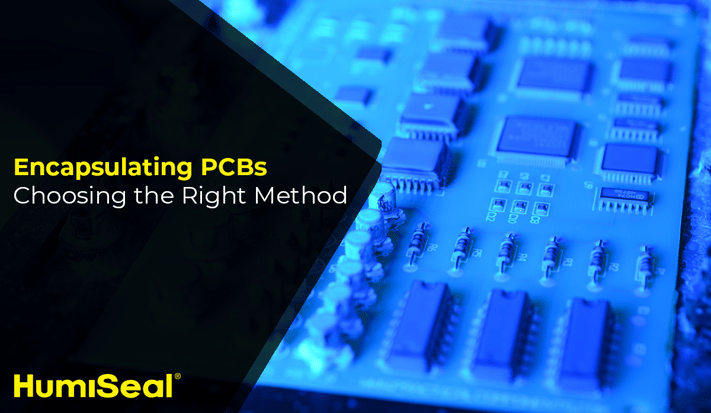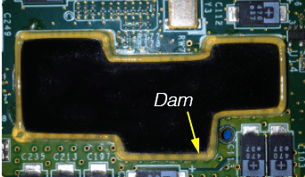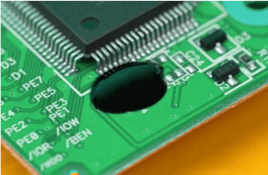
If you're familiar with HumiSeal through our blogs, you know we are big fans of conformal coatings. This is for good reason; with advancing conformal coating technology, innovative LED and UV curable coatings offer incredible protection for a large range of applications.
Conformal coatings are just one method of circuit board protection available to engineers. Those involved with PCBs may be familiar with the terms encapsulation. Encapsulation is a tremendously powerful method to secure and protect PCBs by submerging them in a protective material. In many cases, this is more desirable than selectively applying conformal coatings.
Why is that? Well, encapsulants promote assembly protection by:
- creating environmental seals that protect against moisture and corrosion
- providing high-temperature resistance
- increasing mechanical shock and vibration-resistance
- generating strong bonds to a variety of substrates
- maintaining low shrinkage
- offering thermal conductivity
Encapsulating can be far more involved than simply dunking a PCB in protective liquid (that said, selective dipping PCBs in conformal coatings is a viable option). It's an entire family of techniques designed to heavily coat delicate components. Let's review a few of the common methods of encapsulation so you can determine which strategy is right for your operation.
Related Article: How Best to Protect PCB Mounted Components from Vibration
What are the Different Methods of PCB Encapsulation?
As mentioned, PCB encapsulation is the general process of loading protective material onto the circuit board. These methods range from dunking the entire PCB into protective material to globbing loose chunks of encapsulating fluid onto the general spots you're attempting to target. There's a time and a place for each, and choosing a method is entirely dependent on your application needs.
Before diving into the different methods of encapsulating, let's first review common material types used during this process.
What are Electronics Encapsulents?
Encapsulants are any materials designed to protect devices from extreme operating conditions, mechanical stresses, and electrical shock. This covers a surprisingly large pool of formulations. For instance, HumiSeal encapsulating compounds are formulated from epoxy, urethane, or acrylated urethanes.
These polymers are engineered with a variety of cure mechanisms, granting tremendous flexibility in accommodating your needs. As encapsulation supports a diverse range of material types, you may select the compound that best fits your project requirements.
HumiSeal encapsulants are available as 1K or 2K compounds with medium to high viscosity. Our commitment to your needs goes beyond the standard product portfolio, as we will custom formulate a product to fit your exact specifications.
These encapsulating liquids can be used in the following processes:
Potting or Casing Encapsulation
This is the most straightforward method of encapsulation. It works by assembling a temporary (or in some cases permanent) barrier around the PCB. This frame then allows for liberal pouring of the encapsulating liquid over the entire circuit board assembly. Once cured, the outer casing may be removed. PCB Potting encapsulation completely covers the device and all internal components, burying it in polymer completely.
Related Article: 5 Simple Steps to Eliminate Bubbles in Potting Encapsulants
Dam and Fill Encapsulation
Dam encapsulation takes a similar approach to potting but on a notably smaller scale. When preparing to apply encapsulation material, applicators isolate specific locations on the PCB to coat by drawing a wall around the desired components with a quick-drying material. This creates the "dam" for which this process is named, though the word "reservoir" may be a bit more accurate.
Once the location is outlined and the framing material cured, encapsulation liquid can be safely poured within the dam. This allows for selective enclosure and encapsulation of PCB components, thus limiting additional weight on the circuit board while still ensuring desired parts achieve maximum protection.

Glop Top Encapsulation
Glop top encapsulation is an interesting one. This requires a glop of highly viscous material to be placed delicately over the component. The material will then effectively bubble or dome over a specific area. This is good for very small, selective applications. This method does require materials with suitably high viscosity and flow resistance after application; low-viscosity materials that continue flowing after application can create a mess by traveling beyond the target area.

As a supplier of all major forms and chemistries of conformal coatings, Chase Corporation and HumiSeal® can help you with an unbiased approach to evaluating your application and process. We’ll show you how to maximize efficiency, minimize cost, and improve product reliability. Our outstanding manufacturing and technical support groups can provide your organization with reliable global supply, unmatched quality, and superior technical support.
Do you have any questions?







